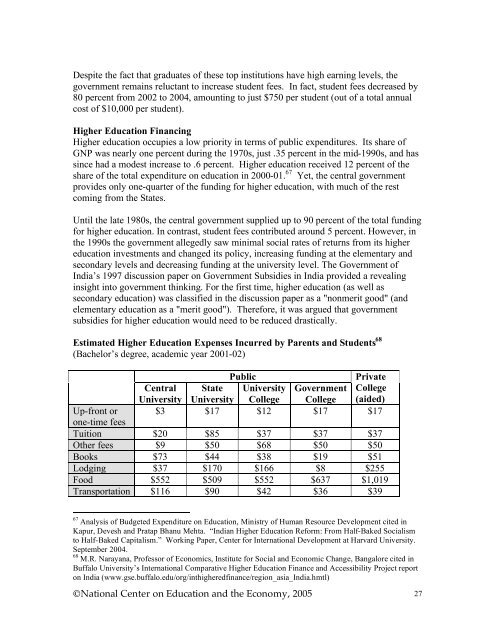India Education Report (2005) - NCEE
India Education Report (2005) - NCEE
India Education Report (2005) - NCEE
You also want an ePaper? Increase the reach of your titles
YUMPU automatically turns print PDFs into web optimized ePapers that Google loves.
Despite the fact that graduates of these top institutions have high earning levels, the<br />
government remains reluctant to increase student fees. In fact, student fees decreased by<br />
80 percent from 2002 to 2004, amounting to just $750 per student (out of a total annual<br />
cost of $10,000 per student).<br />
Higher <strong>Education</strong> Financing<br />
Higher education occupies a low priority in terms of public expenditures. Its share of<br />
GNP was nearly one percent during the 1970s, just .35 percent in the mid-1990s, and has<br />
since had a modest increase to .6 percent. Higher education received 12 percent of the<br />
share of the total expenditure on education in 2000-01. 67 Yet, the central government<br />
provides only one-quarter of the funding for higher education, with much of the rest<br />
coming from the States.<br />
Until the late 1980s, the central government supplied up to 90 percent of the total funding<br />
for higher education. In contrast, student fees contributed around 5 percent. However, in<br />
the 1990s the government allegedly saw minimal social rates of returns from its higher<br />
education investments and changed its policy, increasing funding at the elementary and<br />
secondary levels and decreasing funding at the university level. The Government of<br />
<strong>India</strong>’s 1997 discussion paper on Government Subsidies in <strong>India</strong> provided a revealing<br />
insight into government thinking. For the first time, higher education (as well as<br />
secondary education) was classified in the discussion paper as a "nonmerit good" (and<br />
elementary education as a "merit good"). Therefore, it was argued that government<br />
subsidies for higher education would need to be reduced drastically.<br />
Estimated Higher <strong>Education</strong> Expenses Incurred by Parents and Students 68<br />
(Bachelor’s degree, academic year 2001-02)<br />
Public<br />
Private<br />
Central State University Government College<br />
University University College College (aided)<br />
Up-front or $3 $17 $12 $17 $17<br />
one-time fees<br />
Tuition $20 $85 $37 $37 $37<br />
Other fees $9 $50 $68 $50 $50<br />
Books $73 $44 $38 $19 $51<br />
Lodging $37 $170 $166 $8 $255<br />
Food $552 $509 $552 $637 $1,019<br />
Transportation $116 $90 $42 $36 $39<br />
67 Analysis of Budgeted Expenditure on <strong>Education</strong>, Ministry of Human Resource Development cited in<br />
Kapur, Devesh and Pratap Bhanu Mehta. “<strong>India</strong>n Higher <strong>Education</strong> Reform: From Half-Baked Socialism<br />
to Half-Baked Capitalism.” Working Paper, Center for International Development at Harvard University.<br />
September 2004.<br />
68 M.R. Narayana, Professor of Economics, Institute for Social and Economic Change, Bangalore cited in<br />
Buffalo University’s International Comparative Higher <strong>Education</strong> Finance and Accessibility Project report<br />
on <strong>India</strong> (www.gse.buffalo.edu/org/inthigheredfinance/region_asia_<strong>India</strong>.hmtl)<br />
©National Center on <strong>Education</strong> and the Economy, <strong>2005</strong> 27


